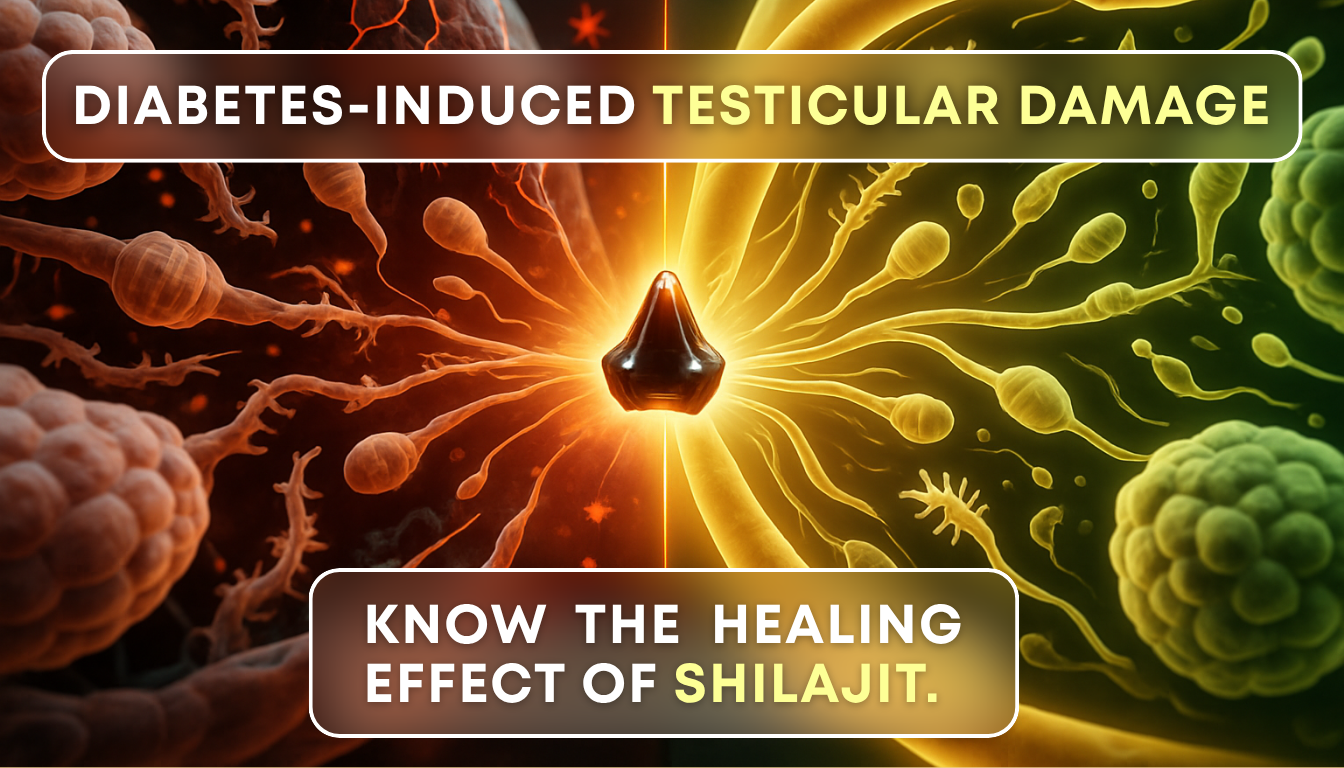Shilajit Mitigates Diabetes-Induced Testicular Dysfunction in Mice

Author : Arti Rajpoot, Ajai Kumar Pandey, Vikas Kumar Roy, Raghav Kumar Mishra — Andrologia (2025)
Diabetes is a chronic metabolic condition that causes testicular damage by high oxidative stress, rendering 35% of afflicted people infertile. Shilajit is a traditional Indian medicine known for its antioxidant, antidiabetic, and aphrodisiac properties. However, its effectiveness on diabetes-induced testicular dysfunction remains unclear. Therefore, the current investigation aimed to determine whether Shilajit could restore testicular functions in diabetic mice. Two days postpartum male Parkes mice received a single intraperitoneal injection of streptozotocin (STZ) (90 mg/kg BW) to induce diabetes. Three months postinjection, the effects of daily Shilajit (100 and 200 mg/kg BW) treatment were evaluated for one spermatogenic cycle in adult diabetic mice, using Empagliflozin (10 mg/kg BW) as a positive control. In STZ-induced diabetic mice, testicular functions were compromised due to disruptions in testosterone biosynthesis, changes in germ-cell ratios, and increased oxidative stress and apoptosis. Shilajit restored glycemic status in diabetic mice by significantly decreasing serum glucose, insulin level, and homeostasis model assessment of insulin resistance (HOMA-IR) value while increasing insulin sensitivity. These effects were comparable to those observed with conventional antidiabetic medication Empagliflozin. Further, Shilajit stimulates steroidogenesis and germ cell dynamics of diabetic mice by increasing the activity of StAR, 3β-HSD, and 17β-HSD enzymes and 1C:2C, 4C:S-Ph, and 1C:4C germ cell ratios, respectively. Shilajit also improves blood–testis barrier (BTB) functioning by increasing expression of ZO-1, Connexin-43, N-Cadherin, and β-catenin as well as oxidative status and apoptosis by modulating NF-E2–related factor 2 (Nrf-2)/heme oxygenase 1 (HO-1) signaling and Bax/Bcl-2 ratio. Subsequently, Shilajit improved the histoarchitecture of testis and epididymis in diabetic mice and recovered both qualitative and quantitative sperm parameters, as seen by higher percentages of sperm motility, viability, and normal sperm morphology as well as increased sperm numbers in cauda epididymis. In summary, Shilajit restores glycemic status, increases insulin sensitivity, stimulates steroidogenesis, and improves testicular functions through Sertoli cell and Nrf-2/HO-1 signaling in STZ-induced diabetic mice.
Key takeaway: The study demonstrates that purified standardized Shilajit (Shilajit‑964; 40% fulvic acid) reverses diabetes-induced testicular damage in mice — restoring glucose homeostasis, improving insulin sensitivity, stimulating steroidogenic enzymes, strengthening the blood–testis barrier, reducing oxidative stress via Nrf‑2/HO‑1 signaling, and recovering sperm quality. These effects at the higher dose were comparable to Empagliflozin.
How this supports VCA Shilajit (VCA‑964)
- Glycemic control: Shilajit reduced fasting glucose, serum insulin, and HOMA‑IR while increasing insulin sensitivity — mechanisms valuable for VCA Shilajit’s antidiabetic positioning.
- Steroidogenesis & fertility: Increased activity of StAR, 3β‑HSD and 17β‑HSD and higher testosterone — supports VCA Shilajit’s claims for reproductive health.
- Antioxidant & cellular protection: Upregulation of Nrf‑2/HO‑1 and decreased Bax/Bcl‑2 ratio — shows VCA Shilajit’s potential to protect testicular tissue from oxidative injury.
- Blood–testis barrier & Sertoli cell function: Increased ZO‑1, Connexin‑43, N‑Cadherin and β‑catenin — indicates structural recovery important for sperm maturation.
- Comparable to drug therapy: High-dose Shilajit effects were comparable to Empagliflozin in many outcomes, strengthening claims for adjunctive nutraceutical use.
Quick bullets (for product pages / marketing)
- Restores glycemic status & increases insulin sensitivity.
- Stimulates testosterone biosynthesis and protects fertility.
- Activates Nrf‑2/HO‑1 antioxidant pathway and reduces apoptosis.
- Improves sperm motility, viability, morphology and counts.
- Effective at 100–200 mg/kg (mouse model); high-dose effects rival Empagliflozin.



